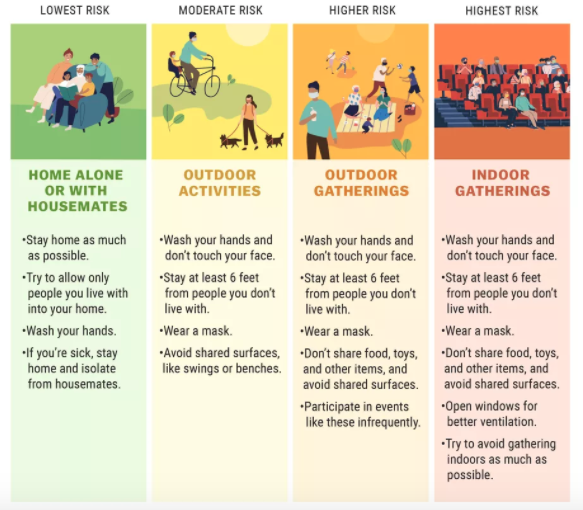Attending an Event or Gathering? Here's What You Need to Know.
At the beginning of quarantine, families and friends took creative measures to see loved ones, with things like FaceTime, Zoom calls and car parades. By now, many communities have reopened to some capacity, which means more people are out doing things such as dining at restaurants, going to parks and attending events.
While the Centers for Disease Control and Prevention (CDC) and World Health Organization (WHO) provide recommendations to help slow the spread of COVID-19, it really comes down to your personal decision. Here are 5 things you need to know if you’re planning on attending an event or gathering.
1. Prepare before you go.
Before you are around others or out in public, ask yourself, “am I feeling sick?” It's important to stay home if you have been diagnosed with COVID-19, if you are waiting for COVID-19 test results or may have been exposed to someone with COVID-19. Other ways to prepare include:
- Check with the organizer or event venue for information about any COVID-19 safety guidelines and if they have steps in place to prevent the spread of the virus.
- Prioritize attending outdoor activities over indoor activities.
- Bring supplies to help you and others stay healthy, such as masks, hand sanitizer with at least 60% alcohol, and drinking water.
2. Use social distancing and limit physical contact.
Remember: COVID-19 can still easily spread from person-to-person, even when someone doesn’t show many symptoms. In order to protect yourself and others:
- Maintain a distance of at least 6 feet or more from people who don't live in your household. Be mindful in areas where it may be harder to keep this distance, such as check-in areas, parking lots and routes of entry and exit.
- Select seating or determine where to stand based on the ability to keep 6 feet of space from people who don't live in your household, including if you will be eating or drinking.
- Arrive to the event early or at off-peak times to avoid crowding and congested areas.
- Avoid using restroom facilities or concession areas at high traffic times, such as intermission, half-time, or immediately at the end of the event.
3. Wear a Mask.

While it might seem like an annoyance, wearing a cloth face covering can provide an extra layer to help prevent respiratory droplets from traveling in the air and onto other people. The CDC strongly recommends wearing a mask in public settings where social distancing measures are difficult to maintain and where individuals might raise their voices, such as shouting, chanting or singing
4. Understand the potential risk of going out.
Assess your own personal risk when deciding whether to participate in activities outside of your home. Things to consider are your age, underlying medical conditions, viral spread in that location and what you can do to reduce your own personal risk in that situation. In general, the more closely you interact with others and the longer that interaction, the higher risk of COVID-19 spread. So, think about:
- How many people will you interact with? Interacting with more people raises your risk, as well as engaging with new people (those who don't live with you).
- Can you keep 6 feet of space between you and others? The closer you are to others who may be infected, the greater your risk of getting sick.
- What's the length of time that you will be interacting with people? Spending more time with people who may be infected increases your risk of becoming infected.
5. Limit contact with commonly touched surfaces or shared items.

- Use touchless garbage cans or pails and cashless payment options when possible. Otherwise, exchange cash or card by placing your payment in a receipt tray, if available, or on the counter.
- Avoid any self-serve food or drink options, such as buffets, salad bars, and condiment or drink stations. Use grab-and-go meal options, if available.
- Wash your hands with soap and water for at least 20 seconds or use hand sanitizer immediately before eating food or after touching any common surfaces like hand rails, payment kiosks, door handles and toilets.
Ultimately, the decision to engage in indoor and outdoor activities is a personal one, but following CDC guidelines can help ensure that you and those around you are safe. By being prepared with a mask and hand sanitizer, using social distancing, and limiting contact with commonly touched surfaces, you can help prevent the spread of COVID-19 while still enjoying time with friends and family
